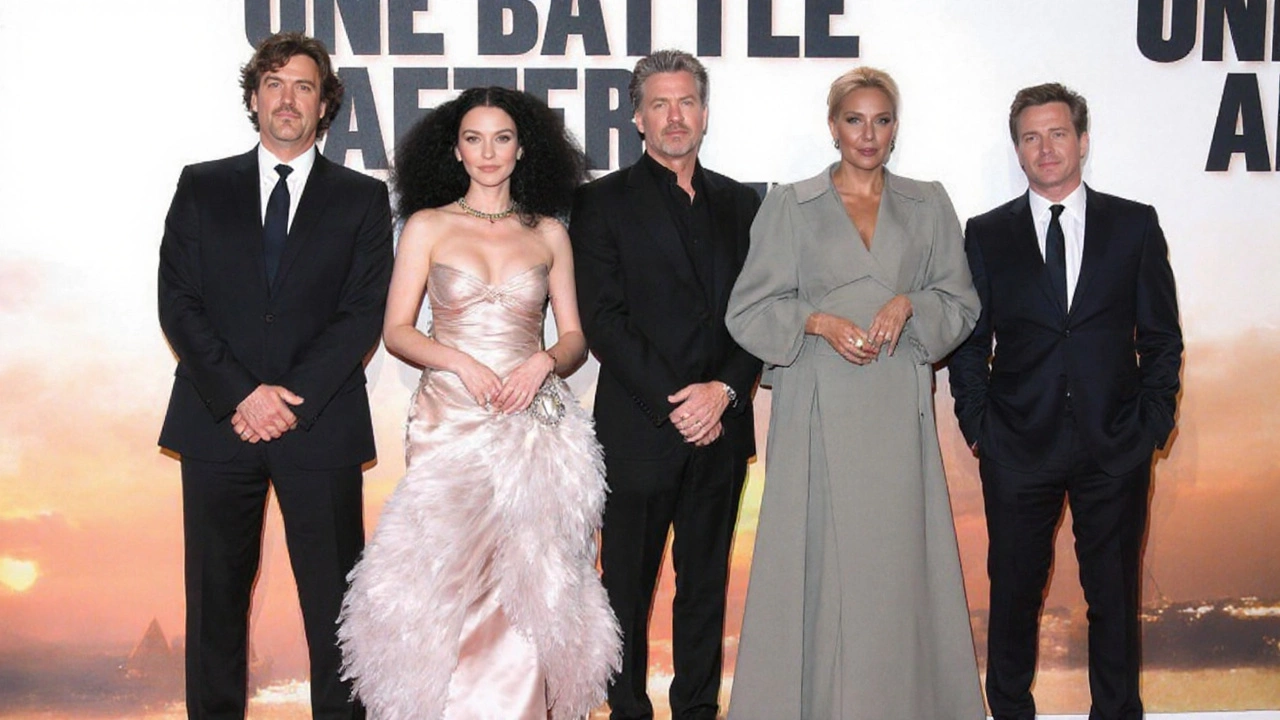Los Angeles lit up on September 8, 2025, when One Battle After Another premiered to a packed house of critics, industry insiders, and eager fans. The moment the lights dimmed, it became clear that director Paul Thomas Anderson was stepping onto a much larger canvas than ever before. Known for intimate, character‑driven dramas such as There Will Be Blood and Phantom Thread, Anderson now offers a sprawling, 161‑minute action thriller that intertwines explosive set pieces with a meditation on the lingering echo of revolutionary fervor.
At the heart of the story is Bob (Leonardo DiCaprio), a former radical who has retreated to an off‑grid existence, haunted by the ghosts of past uprisings and a perpetual state of drug‑induced paranoia. His peace is shattered when his long‑absent nemesis, a cold‑blooded antagonist played by Sean Penn, resurfaces after a sixteen‑year hiatus, and Bob’s teenage daughter Willa (newcomer Chase Infiniti) disappears in the ensuing chaos. The plot unfolds as a relentless chase across a dystopian landscape, pulling the audience into a world where personal vendettas and political ideologies collide.
Anderson’s adaptation draws heavily from Thomas Pynchon’s 1990 novel Vineland, preserving its exploration of political disillusionment while reshaping the narrative for cinematic impact. The film does not simply copy the novel’s intricate plot; instead, it extracts the core tension between generations—old activists grappling with the fallout of their deeds and their children bearing the weight of inherited rebellion. This thematic backbone gives the film a depth that sets it apart from typical blockbuster fare.
Plot and Themes
The opening scenes paint an almost hallucinatory portrait of Bob’s isolated cabin, where the rusted remnants of a guerrilla hideout sit next to a solar array and an ever‑present haze of smoke. DiCaprio’s performance balances a weary resignation with bursts of feral anger, suggesting a man caught between surrender and resurgence. When Willa vanishes, the narrative shifts into high‑gear, introducing a cadre of characters who each embody a different facet of the film’s political spectrum.
Sean Penn’s villainous nemesis, a shadowy figure known only as The Architect, embodies the ruthless pragmatism of a new generation of power brokers. His return forces Bob to confront not only the physical threat to his daughter but also the ideological betrayals of his own past. Supporting players—Benicio del Toro as a disillusioned ex‑militant, Regina Hall as a pragmatic journalist, and Teyana Taylor as a street‑wise liaison—populate the story’s sprawling map, adding layers of loyalty, betrayal, and redemption.
Beyond the chase, the film probes the long‑term cost of revolutionary idealism. Anderson uses visual motifs—crumbling murals, faded protest signs, and abandoned factories—to underscore how once‑vibrant movements can erode into myth or be co‑opted by new powers. The title itself, One Battle After Another, echoes the endless cycle of struggle, suggesting that every victory spawns another front, both personal and political.
In a notable departure from his usual literary adaptations, Anderson lets the action speak for the ideological undercurrents. Car chases, rooftop gunfights, and a climactic showdown in a repurposed industrial warehouse are all choreographed not merely for spectacle but to illustrate the characters’ internal conflicts. The frenetic pacing rubs shoulders with quieter, introspective moments—Bob’s solitary reflections on a broken radio, Willa’s whispered journal entries—that keep the narrative grounded.

Production, Cast, and Reception
The film’s production values are as ambitious as its story. Cinematographer Michael Bauman, who previously collaborated with Anderson on Phantom Thread, employs a mix of anamorphic lenses for intimate close‑ups and expansive 70mm film for the sweeping action sequences. The choice to shoot in VistaVision and 70mm provides a tactile richness that is amplified in IMAX screenings, allowing audiences to feel the texture of dust‑caked streets and the weight of collapsing walls.
Production designer Florencia Martin, an Oscar nominee, builds a world that feels both lived‑in and symbolic. From the decayed graffiti‑covered alleys of a fictional American city to the high‑tech command center of The Architect, each set is layered with relics of past protests—tattered banners, graffiti that reads “Stay Rad”—creating a visual narrative of decay and resurgence.
Jonny Greenwood’s score weaves an unsettling electronic pulse with orchestral swells, echoing the film’s dual nature of intimate drama and grand spectacle. The music crescendos during chase scenes, then recedes into sparse piano motifs during Bob’s reflective moments, reinforcing the emotional stakes without dictating them.
The ensemble cast delivers performances that have already become a talking point among critics. DiCaprio, often praised for his chameleon‑like ability to inhabit diverse roles, brings a raw, almost vulnerable edge to Bob, allowing the audience to see beyond the hardened exterior. Chase Infiniti, despite being a newcomer, holds her own, portraying Willa with a mix of teenage defiance and subdued fear that feels authentic. Sean Penn’s portrayal of The Architect is chilling in its calm, a stark contrast to the chaotic world around him.
Warner Bros. Pictures has shown confidence in the project by releasing it in multiple premium formats, including IMAX, 70mm, and a limited 4DX run that adds physical effects like seat vibration during the film’s explosive set pieces. The wide release strategy—over 3,200 theaters across the United States—signals the studio’s belief that the film will attract both art‑house audiences and mainstream action fans.
Early reception has been overwhelmingly positive. The Los Angeles premiere garnered a standing ovation, and the film quickly rose to an 8.6/10 rating on IMDb, based on more than 7,400 user reviews within its first week. Critics have highlighted Anderson’s ability to balance “intimate character beats with blockbuster‐level set pieces,” noting that the film “never sacrifices depth for spectacle.” Movies that traditionally dominate the box office this season—big‑budget superhero sequels and franchise reboots—have found a serious contender in Anderson’s offering.
Beyond the numbers, cultural commentators are already debating the film’s relevance. In an era marked by renewed activism and global protests, the narrative’s focus on generational fallout from political movements feels timely. Yet Anderson avoids preaching, opting instead to let his characters embody the complexities of idealism gone awry. This subtlety has sparked discussions on talk shows and social media, with viewers dissecting scenes frame by frame to uncover hidden symbolism.
“One Battle After Another” also marks a notable shift in Anderson’s collaboration pattern. Long‑time partners such as editor Andy Jurgensen and costume designer Colleen Atwood return, but the inclusion of musicians‑turned‑actors like Teyana Taylor and Alana Haim signals Anderson’s ongoing attraction to talent that bridges multiple artistic worlds. This blend of seasoned veterans and fresh faces contributes to the film’s dynamic energy.
As audiences continue to stream the first week’s box‑office numbers, industry analysts predict “One Battle After Another” will not only be a financial success but also a cultural touchstone that shapes conversation around cinema’s capacity to engage with politics without becoming didactic. Anderson’s daring fusion of narrative depth, star power, and technical brilliance sets a new benchmark for what an auteur‑driven action thriller can achieve.




